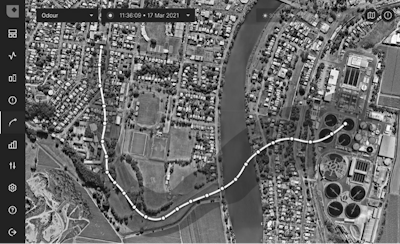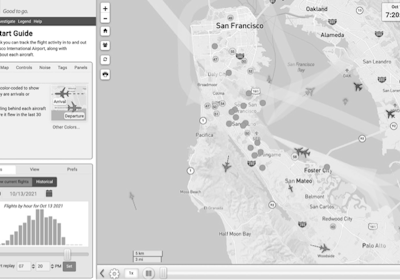Balancing output while maintaining trust in your operations with surrounding communities is a challenge that a wide range of sectors face. This certainly isn’t uncommon for large open-pit mines, the world’s major airports, waste management sites and water treatment facilities.
While meeting community expectations is a must, many of the environmental risks that are managed on a day-to-day basis are highly complex and difficult to communicate in layperson’s terms.
Until recently most aspects of environmental management at industrial facilities relied on manual processes and specialist knowledge of external consultants. This left a burden on teams who were left with responsibility to make complex decisions to future proof their facilities without immediate access to specialists or the right information.
Lack of the right information or context to environmental monitoring data make it difficult to stay compliant with local regulations and keeping community relationships intact. For any operation, this is detrimental to financial success in a future that will continuously demand transparency.
What is environmental management software?
In today’s market, ‘environmental management software’ certainly means different things to different people.
Most offerings span an array of different categories including carbon management, water management or high-level data that tracks corporate sustainability goals.
However, most environmental management software focusses collection, storage and only sometimes, the display of historical information regardless of the value or context that a particular platform may bring the end user.
Although useful for reporting on issues that have happened in the past, analysis of complex data such as air quality, noise or water parameters is time consuming and difficult for non-subject matter experts. Most community members near a facility’s perimeter may not understand the intricacies complex environmental data either.
Environmental Intelligence (EI) is beginning to usher in new methods and technology to support operational decisions. EI uses real-time data and advanced insights based on local weather and IoT data being collected at facilities.
Industrial operators can now make swift, well-informed decisions based on advanced modelling of weather and monitoring data from multiple parameters – while also avoiding chronic problems and preserving their reputation.
EI is also changing the way useful information is displayed so community members can be educated while submitting their own observations. The goal is to order build social licence to operate and tolerance of industrial operations or airports in their neighbourhood.

The world’s major airports use data from environmental intelligence to communicate flight paths and potential noise impact to nearby communities.
How can environmental management software resolve community complaints effectively?
Over the last few decades, public expectations for how issues such as odour are managed have grown. For many industries, this has led to an increase in the number and frequency of complaints directed at facilities.
For operators dealing with community complaints understand how disruptive they can be, even when only a handful have been submitted. – whether they’re focussed noise, air quality, dust, odour or vibration.
Operational teams not only need to find the source of the issue, but also need to determine a suitable resolution and implement it quickly and effectively. Most of the time, this is no simple task.
For many businesses, incidents involving noise, air quality and vibration and similar are notoriously difficult to navigate. There are a few reasons for this, from the impact of rapidly changing weather to the fact that the problem is often invisible, which makes it harder to trace. Analysing and interpreting the data collected by most environmental monitoring systems - which only provides a static reading without context to the source of the issue – make it even more difficult.
Furthermore, at the end of lengthy investigations, results are often inconclusive, and the opportunities for operational improvement have passed.
When it comes to improving complaint resolution times while taking targeted preventative measures to stop certain issues from arising, environmental management software has emerged as a practical and reliable solution.

Industrial facilities are now using environmental intelligence to determine the source of air quality or odour complaints in the community.
What other benefits can environmental management software bring industrial operations and airports?
Operators can use proactive environmental management software to interpret and act on real-time data and operational insights from a range of different sources.
This is enables fast, informed decisions that can boost operational efficiency, upkeep employee health and safety, maintain regulatory compliance and most importantly – strengthen community relationships.
Environmental management software combines complex monitoring data, highly accurate weather forecasting and emissions modelling to provide a holistic and easy-to-understand picture of your facility at any given time or in the future.
When a complaint is made, software can drastically reduce investigation times, so you can respond swiftly and effectively.
This often starts with refuting or accepting responsibility, and then personnel can work backwards from the location of the incident to find the cause of the problem using processes like reverse trajectory modelling. With this information you can not only make required changes – and effectively allocate resources to do so – but also communicate transparently with communities every step of the way.
Envirosuite’s practical and proactive environmental management software
If your approach to environmental management isn’t easily understood at your facility, Envirosuite’s user-friendly and accurate software offer the ideal solution.
We provide a range of environmental intelligence platforms for all environments, which are:
EVS Omnis: a cloud-based environmental management software that provides real-time monitoring data, weather forecasting and emissions modelling for air quality, dust, water quality, odour, noise and vibration.
EVS Water: advanced water treatment software that helps you design industrial processes in under a day, forecast for water compliance, and improve management of corrosion and odour risks in municipal sewer networks.
EVS Aviation: environmental management software designed for airport personnel that need to manage complex noise issues, maximise capacity utilisation, optimise maintenance work and communicate transparently with local communities and government.
EVS IoT: accurate real-time environmental monitoring devices for airports, industrial operations and urban areas looking to improve management of air quality, odour, weather, noise and vibration. This includes hardware like eNose Ambient, Noise Logger and Vibration Monitoring Terminal.
Built on 30+ years of expertise, our software is trusted on a global scale. With Envirosuite’s environmental management software, you can collect and interpret complex data, address operational challenges and build trust with stakeholders.
Talk to us today find out more about environmental management software
Designed for rapid deployment, our monitoring and forecasting solutions can be implemented in as little as a few days. Contact us to talk with our team about your environmental management requirements.
